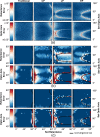Design considerations for polarization-sensitive optical coherence tomography with a single input polarization state
- PMID: 23024919
- PMCID: PMC3447567
- DOI: 10.1364/BOE.3.002273
Design considerations for polarization-sensitive optical coherence tomography with a single input polarization state
Abstract
Using a generalized design for a polarization-sensitive optical coherence tomography (PS-OCT) system with a single input polarization state (SIPS), we prove the existence of an infinitely large design space over which it is possible to develop simple PS-OCT systems that yield closed form expressions for birefringence. Through simulation and experiment, we validate this analysis by demonstrating new configurations for PS-OCT systems, and present guidelines for the general design of such systems in light of their inherent inaccuracies. After accounting for systemic errors, alternative designs exhibit similar performance on average to the traditional SIPS PS-OCT system. This analysis could be extended to systems with multiple input polarization states and could usher in a new generation of PS-OCT systems optimally designed to probe specific birefringent samples with high accuracy.
Keywords: (110.4500) Optical coherence tomography; (120.3890) Medical optics instrumentation; (230.5440) Polarization-selective devices.
Figures





References
-
- Hee M., Huang D., Swanson E., Fujimoto J., “Polarization-sensitive low-coherence reflectometer for birefringence characterization and ranging,” J. Opt. Soc. Am. B 9, 903–908 (1992).10.1364/JOSAB.9.000903 - DOI
LinkOut - more resources
Full Text Sources
Other Literature Sources
